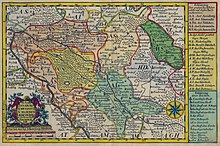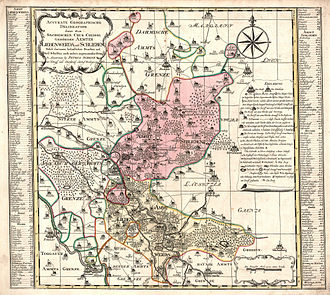Liebenwerda Office


The Liebenwerda office was an administrative unit of the Electorate of Saxony , which was converted into a kingdom in 1806, and was affiliated to the Kurkreis .
Until it was ceded to Prussia in 1815, as a Saxon office it formed the spatial reference point for the collection of sovereign taxes and compulsory services , for the police , jurisdiction and military service .
Geographical expansion
The Liebenwerda office was located in the southeast of the spa district on the border with Niederlausitz . To the east of the office was the Liebenwerdaer Heide . The Black Elster crossed the territory from south to north. The official area is now in the state of Brandenburg on the border with the Free State of Saxony .
Adjacent administrative units
| Office Annaburg | Office close | |
| Office Schweinitz (exclave) |

|
Markgraftum Niederlausitz ( Dobrilugk Office ) |
| Mühlberg Office | Grossenhain office |
history
The Liebenwerda Electoral Office was created from the old Liebenwerda nursing home . In the 13th century the area belonged to the County of Brehna , in 1301 it was under Markmeißnischer suzerainty. After 1360 the area was owned by the Electors of Saxony-Wittenberg and became Wettin in 1423 . From the division of Leipzig in 1485, the official area was not affected as an accessory to the electoral territory and remained under the rule of Elector Ernst as the founder of the (older) Ernestine line. With the Battle of Mühlberg in 1547 and the resulting Wittenberg surrender , the Albertines now took over the rule and electoral dignity in Electoral Saxony.
The state administration of the Electorate axes was of Frederick the ways by adopting the electoral Hofrath order controlled by the 1499th The lowest level of the administrative organs in the electorate were the offices. The offices existed since the Middle Ages . They were smaller districts that were also called bailiwicks or foster care . In addition to the offices there were spiritual possessions and the territories of knightly landlords . In the middle between these the offices of the sovereign were scattered like islands.
The official mill in Liebenwerda with 5 grinding courses bore 57 ß on account. 29 gr. And in 1538 the fulling mill and board mill was given to the Liebenwerda council in return for a tax in kind and amount of 39 ß. 5 gr., The official mill in Warenbruck with 6 grinding courses to the council in Liebenwerda for 44 ß. inherited. The castle fields in Liebenwerda, previously Lassgut, and the fiefdom of the forester in Dobra were inherited, as were the two vineyards in the same year 1538 to 10 men in Liebenwerda, which had previously been 33 ß. 9 gr., To the third part of the office, which annually on average 42 buckets 17 jugs of 57 1/2 gr. = 37 ß. he carried; the associated services were turned into money.
In order to secure the income and to organize it more tightly, from 1506 official inheritance books were created for the individual offices, in which all sovereign possessions, rights and income in the district of the respective office were recorded. This gave the elector and his councilors a precise overview of his property. The Liebenwerda office had certain rights that ensured him an income. Only the Fiscal Woods and the large fishing net, which had to be borrowed from local fishermen for a fee, are mentioned here, because fishing and hunting were typical sovereign rights ( regalia ). The office was originally headed by a Vogt (Vocatus) belonging to the knighthood. Since the end of the 15th century, the term Amtmann (also captain) was in use. In addition to the bailiff, who administered the judicial and police matters, there has also been the Schösser , who was responsible for economic and financial administration, in the larger offices since the 15th century . If necessary, he represented the bailiff, and sometimes he was the head of an office. At the end of the 18th century, the office had a judicial officer, an office inspector and office leaseholder, and an office inspector who was also a rentier. Liebenwerda Castle was the seat of the Liebenwerda administration . When the Elector of Saxony was promoted to king in 1806, the office became part of the kingdom . In the spring of 1815, due to the regulations at the Congress of Vienna, the northern part of the Kingdom of Saxony and thus the Liebenwerda office had to be ceded to Prussia. About 9,857 residents lived in the Liebenwerda district. During the subsequent administrative reorganization in 1816 the Liebenwerda office became the Liebenwerda district in the new province of Saxony .
Components
Cities
Villages
|
|
|
|
Officials
- Johann Christoph Bielitz , bailiff until 1765
- Johann Alexander Bielitz , bailiff from 1765 to 1783
- Christian August Schulze , bailiff until 1821
Individual evidence
- ↑ PRIZE CHARACTERISTICS CROWNED AND PUBLISHED BY THE PRINCELY JABLONOWSKISCHEN GESELLSCHAFT ZU LEIPZIG, Johannes Falke: The story of the Elector August von Sachsen in Vollkswirthschaftlicher relationship , 1867, p
- ↑ Friedrich Gottlob Leonhardi: Earth description of the electoral and ducal Saxon lands - 1802
literature
- Karlheinz Blaschke , Uwe Ulrich Jäschke : Kursächsischer Ämteratlas , Leipzig 2009, ISBN 978-3-937386-14-0
- Karlheinz Blaschke, (Ed.): Historical local directory of Saxony , Leipzig 2006, ISBN 3-937209-15-8
Web links
- Digital historical place directory of Saxony - Office directory - The Liebenwerda office in the historical place directory of Saxony
- D 24 Liebenwerda Office (PDF; 297 kB) - The Liebenwerda Office on the homepage of the State Archive of Saxony-Anhalt
